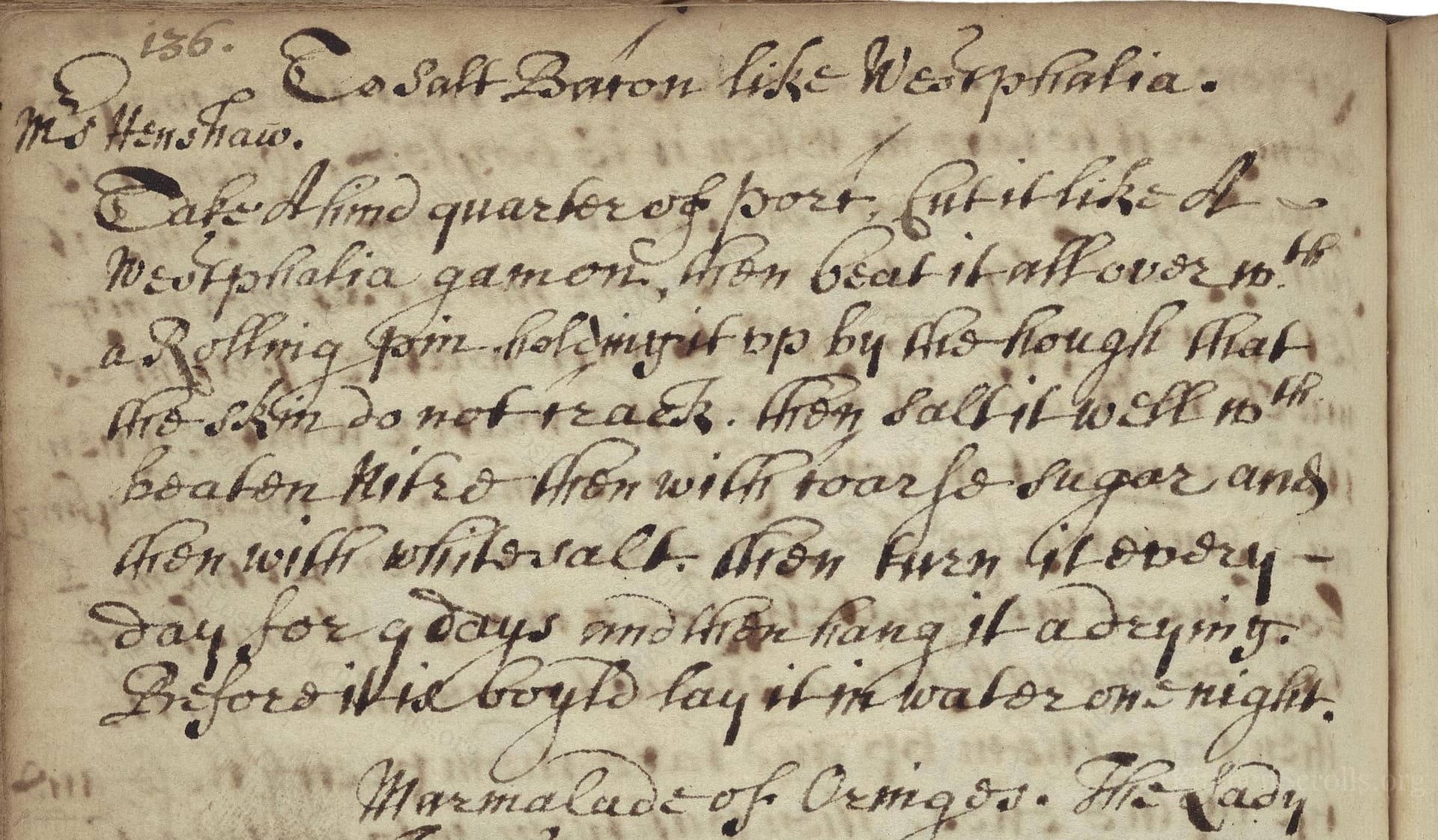To Salt Baron Like Westphalia
From the treasured pages of Receipt book of Penelope Jephson
Written by Penelope Patrick

To Salt Baron Like Westphalia
"Take a hind quarter of pork, cut it like a Westphalia gamon. then beat it all over with a Rolling pinn holding it up by the hough that the skin do not crack. then salt it with salt beaten mixed then with coarse sugar and salt. then with white salt. then turn it every day for 4 days and then hang it a drying before the boyld lay it in water one night."
Note on the Original Text
Early recipes like this were written as practical reminders or guides for the experienced cook, not for beginners. Measurements are vague and rely on the cook's familiarity with the process and local ingredient sizes. Spelling and phrasing are inconsistent by modern standards ('gamon', 'boyld', 'hough'), and grammar is informal. Instructions are given as continuous prose rather than as separated steps or lists, typical of manuscript cookery collections of the 17th century.

Title
Receipt book of Penelope Jephson (1673)
You can also click the book image above to peruse the original tome
Writer
Penelope Patrick
Era
1673
Publisher
Unknown
Background
Step back into the sumptuous kitchens of the late 17th century with Penelope Patrick’s culinary collection—a feast of historic recipes, secret tips, and the irresistible flavors of Restoration England all bound together in a handwritten treasure.
Kindly made available by
Folger Shakespeare Library
This recipe dates from between 1671 and 1675 and was recorded by Penelope Patrick (1646-1725), a woman of the English gentry. At this time, salt preservation was the cornerstone of meat-keeping, particularly in winter months. The recipe attempts to recreate the famous 'Westphalia ham', a German delicacy renowned across Europe for its flavour and keeping qualities. Such recipes appeared in English households as people sought to imitate fashionable European foods. The original manuscript source shows a period when domestic cookery was both experimental and deeply reliant on traditional methods of salting and air drying to preserve meats safely for months.

The process originally would require a heavy wooden rolling pin to tenderize the pork without damaging the skin. A large wooden or ceramic curing trough or dish would be typical for salting. Turning the meat daily ensured even absorption of the salt. For drying, a meat hook and a cool, ventilated larder or smokehouse, with space to hang the ham, would have been essential indoors or out. Soaking would take place in a large ceramic or wooden tub filled with clear water.
Prep Time
30 mins
Cook Time
3 hrs
Servings
15
We've done our best to adapt this historical recipe for modern kitchens, but some details may still need refinement. We warmly welcome feedback from fellow cooks and culinary historians — your insights support the entire community!
Ingredients
- 1 hind quarter of pork (9–11 lb)
- 7 oz coarse sea salt
- 3.5 oz fine white salt
- 1.75 oz coarse sugar (or demerara as substitute)
- Fresh water (for soaking)
Instructions
- Begin with a hind quarter of pork, approximately 9–11 lb in weight.
- Cut it similarly to a Westphalian ham, focusing on a large 'gammon'-style cut with the bone in and skin intact.
- Using a sturdy rolling pin, lightly beat the pork to tenderize without breaking the skin—hold the leg (hock) so the skin stays whole.
- For the cure, mix 7 oz of coarse sea salt with 1.75 oz of coarse sugar.
- Rub this mixture thoroughly all over the pork, making sure the entire surface is well-coated.
- Add an additional sprinkling of 3.5 oz fine white salt over the surface.
- Place the ham in a non-reactive dish or tray, cover, and store in a cool spot (below 46°F, such as a refrigerator or cool cellar).
- Turn the pork every day for 4 days so it salts evenly.
- After 4 days, remove the ham and hang it in a cool, airy place to dry for several days (up to a week, depending on climate and humidity).
- Before boiling or roasting, soak the dried ham in a large tub of fresh cold water overnight (8–12 hours) to remove excess salt and rehydrate the meat.
Estimated Calories
400 per serving
Cooking Estimates
Preparing the ham takes about 30 minutes, including trimming, mixing the cure, and rubbing it over the meat. The salting and drying times occur while you wait. The actual cooking time will depend on how you choose to finish the ham (boil or roast), but typically boiling takes about 3 hours for a ham this size. Each serving contains an estimate of 400 calories, and you can expect to get about 15 servings from a 4-5 kg leg.
As noted above, we have made our best effort to translate and adapt this historical recipe for modern kitchens, taking into account ingredients nowadays, cooking techniques, measurements, and so on. However, historical recipes often contain assumptions that require interpretation.
We'd love for anyone to help improve these adaptations. Community contributions are highly welcome. If you have suggestions, corrections, or cooking tips based on your experience with this recipe, please share them below.
Join the Discussion
Rate This Recipe
Dietary Preference
Main Ingredients

Den Bockfisch In Einer Fleisch Suppen Zu Kochen
This recipe hails from a German manuscript cookbook compiled in 1696, a time whe...

Die Grieß Nudlen Zumachen
This recipe comes from a rather mysterious manuscript cookbook, penned anonymous...

Ein Boudain
This recipe comes from an anonymous German-language manuscript cookbook from 169...

Ein Gesaltzen Citroni
This recipe, dating from 1696, comes from an extensive anonymous German cookbook...
Browse our complete collection of time-honored recipes



